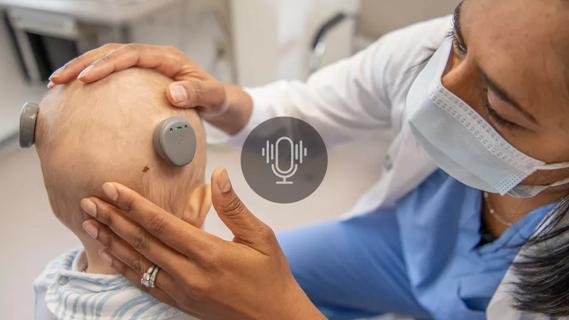Advertisement
Customized vocal solutions for diverse patient journeys
Advertisement
Cleveland Clinic is a non-profit academic medical center. Advertising on our site helps support our mission. We do not endorse non-Cleveland Clinic products or services. Policy
When providing gender-affirming voice care, it’s important for providers to recognize that every patient has their own unique goals. For example, some patients may be more concerned with pitch, while others may be more focused on the weight of their voice. Patients also present at different stages in terms of their vocal journey — some may have had vocal surgery or vocal therapy, while others may not be as far along.
In a recent Head and Neck Innovations podcast episode, Bethany Beckham, MA, CCC-SLP, a speech-language pathologist in Cleveland Clinic’s Voice Center, explains why it’s so important for providers to listen to their patients and be able to provide them with the best tools to achieve their goals.
“Patient preference is so important in all of this,” says Beckham. “If a patient comes to you and they're particularly interested in one type of treatment, it's our job to support them in that and guide them through that.”
The episode also covers:
Click the podcast player above to listen to the episode now, or read on for a short edited excerpt. Check out more Head and Neck Innovations episodes at clevelandclinic.org/podcasts/head-and-neck-innovations or wherever you get your podcasts.
Advertisement
Podcast host Paul Bryson, MD, MBA: It probably takes a little bit of time to get to know people, and it requires a lot of listening, empathy and understanding. So, I could imagine that where you start may not be totally where you end, and you might learn stuff as you go along. That changes the recipe a little bit.
Bethany Beckham, MA, CCC-SLP: Yeah, absolutely. I think it's really important that patients feel comfortable with me and with themselves between practice sessions when they can try on these new voices, even if it's just doing a certain accent or something that feels very out of the realm, that can sometimes get you to notice things about a voice that you might like more. I always tell patients, you're not married to this voice that you're doing in here at this moment. If you try this one thing, then we can talk about what you like or what you do not like about it.
There are definitely people that I've learned from, and some titans in the gender-affirming voice field that I've learned a lot of things from, one of them is what I believe Sandy Hirsh, Christie Block, and Leah Helou call “voice drafts.” Basically, if patients are comfortable with it, we will have them record a voice draft that could be a phrase, or a sentence, or however long the time that we're working on isn't what they feel comfortable with.
Then we listen to it, and I let them pick one thing that they like or dislike. And that way, it helps limit patients feeling super overwhelmed by everything. It's like we're not talking about your voice as a whole; we're talking about this one moment in time. What is one thing that you like or one thing that you dislike about your voice? And I think that takes some of the pressure off them.
Advertisement
Then the other part of it is, and this is not just a gender-affirming patient care thing, this is something for all patients that I see for voice therapy — I know we've probably known this too — it is so different to hear your voice back than how it sounds in your own head. There's definitely that cognitive dissonance. So sometimes being able to listen back to that voice, they're like, oh, this sounds a lot more feminine, or a lot more masculine or a lot more androgynous than how I thought it did in my head. And so that can be a conversation to have too — what if what we're hearing back is more of what other people are hearing? I’ve found that being able to adjust that too has been a really helpful tool.
Advertisement
Advertisement

New innovations in upper airway care and insights into the Pediatric Voice Center

A deep dive into the evolution of surgical sleep therapy

A commitment to sharing expertise has fostered a global exchange of ideas

How a new clinic is helping to streamline evaluations for patients

A multidisciplinary approach and individualized plan of care are imperative

Insight on larynx disorders and treatments

Novel procedures provide options for patients who can’t tolerate CPAP

Research on children with UHL explores the quality-of-life benefits and outcomes of cochlear implants